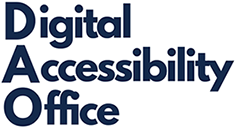Top 10 Tips for Digital Accessibility
All digital content created for UNC business must be accessible to all users. Based on the Web Content Accessibility Guidelines (WCAG), these tips are a starting point for accessibility. WCAG is an internationally accepted set of guidelines published by the World Wide Web Consortium, or W3C. At UNC, we aim for WCAG 2.0 levels A and AA. See our Digital Accessibility Policy for more details.
Headings
Use headings instead of large or bold text to break content into skimmable sections. They also give your content structure making it easier to read. This is especially important for screen reader users who may navigate by headings.
Consistent layout
A consistent layout helps to keep viewers oriented from page to page. It also sets their expectation of interactive elements such as navigation.
Keep it text
Try to avoid images of text and instead use actual text whenever possible. Images of text can become pixilated or blurry when zoomed in. The alternative text must include the exact text found in the image.
Text size and spacing
Keeping your text size and spacing at the default for whichever platform you are using will ensure the best accessibility. When you make text too small, or squish the lines together with poor spacing it can cause it to be hard to read.
Plain language
Content written in plain language can ensure that users can quickly understand and act on your content.
Descriptive link text
Like headings, distinguishing links from other text on a page makes content easier to skim. Screen readers and other assistive technologies allow users to browse a website by links only.
Color contrast
Ensuring that your text and background colors have a high enough contrast will help improve readability of your content for all users.
Alternative text
Alternative text is the text equivalent of an image in context. If the image is unavailable, web browsers display the text for users or screen readers read it.
Captions and transcripts
Like alternative text on images, captions provide a text alternative for video content. Transcripts provide the same for audio-only content like a podcast.
Ask the DAO
The above tips are a starting point. Our approach focuses on accessibility as a process, not a one-time project. The Digital Accessibility Office is here to help you make all your digital content accessible. Schedule a consultation with us via the Online Help Desk and we will be happy to discuss your projects.
